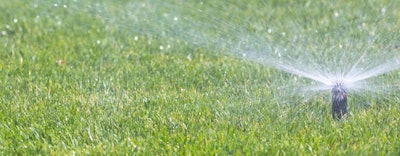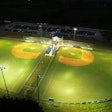
College campuses nationwide are getting greener, focusing on environmental sustainability, from designing LEED-certified buildings to launching zero-waste recycling campaigns and taking "Carbon-Neutral" pledges. College athletic programs are doing their part, increasing energy efficiency through the use of LED lighting and alternative energy sources, reducing water consumption and implementing gameday recycling programs.
One area of green initiatives getting less attention is the greens themselves. Natural turf athletic and recreation fields don't seem like they would offer much potential for increased sustainability, since a regimen of chemical applications, mowing and irrigation is often needed to keep many in pristine playing condition, resulting in consumption of resources and the creation of waste. "It takes a lot of care and knowledge on our side to make sure we're being as eco-friendly as we can and still maintain the level of quality expected for a Division I soccer field, as well as with our baseball and softball stadiums," says Raimond Calderon, superintendent of grounds at the University of California, Santa Barbara, whose grounds crew was recently recognized by the Professional Grounds Management Society for its commitment to high-quality landscaping and sustainable practices.
Log in to view the full article
College campuses nationwide are getting greener, focusing on environmental sustainability, from designing LEED-certified buildings to launching zero-waste recycling campaigns and taking "Carbon-Neutral" pledges. College athletic programs are doing their part, increasing energy efficiency through the use of LED lighting and alternative energy sources, reducing water consumption and implementing gameday recycling programs.
One area of green initiatives getting less attention is the greens themselves. Natural turf athletic and recreation fields don't seem like they would offer much potential for increased sustainability, since a regimen of chemical applications, mowing and irrigation is often needed to keep many in pristine playing condition, resulting in consumption of resources and the creation of waste. "It takes a lot of care and knowledge on our side to make sure we're being as eco-friendly as we can and still maintain the level of quality expected for a Division I soccer field, as well as with our baseball and softball stadiums," says Raimond Calderon, superintendent of grounds at the University of California, Santa Barbara, whose grounds crew was recently recognized by the Professional Grounds Management Society for its commitment to high-quality landscaping and sustainable practices.
"UCSB has been on the forefront of recycling and sustainability on a university campus," Calderon says. "It started some years ago and just carried over to the grounds crew."
INPUT METHOD
The most obvious solution to reducing the environmental impact of turf maintenance might seem to be to reduce the application of chemicals such as fertilizers and pesticides, but for educated and budget-minded turf care professionals, there is little room for improvement in this area. "We get the brunt of the bad reputation for what society is doing — putting chemicals in groundwater and things like that," says Jeff Salmond, director of athletics fields at the University of Oklahoma. "But we have a budget and want to make the best use of it. We're more aware of the environment and know what products are needed, their benefits and how they're best taken up by the plant."
The grass on athletic fields also requires a different level of attention than turf in other areas.
"Athletic fields are not lawns," says Brad Park, sports turf research and education coordinator at Rutgers University. "People look at general lawn maintenance and see low-input lawns and want to apply those same concepts to athletic fields. But some of these surfaces are highly trafficked and can be very susceptible to weed encroachment and compaction. Inputs are required — aeration, overseeing, pesticides when necessary."
RELATED: Environmental Turf Managers Feed Their Fields Naturally
Recognizing that not all turf areas take the same beating, the grounds crew at UCSB has worked to offset the chemical input required on its athletic fields in other areas. "We've reduced fertilizer applications on the core campus," says Calderon, estimating that the athletic fields account for about 85 percent of the crew's chemical use. "Our soccer stadium is like a big fairway for a golf course. We use different applications there, but we try to stay with chemicals that are pretty environmentally friendly."
Though EPA regulations have done away with the most hazardous of chemical applications, there is still a wide range of choices, some more environmentally friendly than others — and some better suited for a specific use. "Sometimes the percent of nutrients we need for the grass isn't quite there," Salmond says. "We still use some synthetic fertilizers, but we've moved a lot to turkey- or chicken-manure fertilizers."
At UCSB, grounds crew members know exactly what goes into many of the fertilizers they apply to their fields — they make many of them themselves. A collaborative effort with campus coffee vendors — Grounds for Grounds — diverts more than 20 tons of coffee grounds a year from landfills and repurposes it as a fertilizer component, providing a valuable source of nitrogen to the grass. "We hand out buckets to each coffee station, and one of our crew members goes around and checks the buckets in the morning, the afternoon and again in the evening," Calderon explains. "All the stations contribute and we pick it up and distribute it. We don't have enough just yet to apply to our baseball fields, but we seem to be making a pretty big impact on the smaller venues."
WATER WISE
Reducing water consumption is a priority of any facility or program looking to be greener. With the state of California suffering its worst drought in 1,200 years, to say that water is a precious commodity would be an understatement. UCSB, like its peers in the California school system, have had years of practice in efficient irrigation. "Years ago, we built a reclaimed-water plant for the city of Galena in exchange for potable water," he says. Now, about 85 percent of the water they use on campus is reclaimed stormwater and runoff. "We almost can have as much reclaimed water as we want, but we still have to manage it. We don't want it pooling or running off into other areas."
And, as befitting a school located in the same state as Silicon Valley, they manage it with computers. "We have a system of irrigation controls," Calderon says. "We have our own weather station on campus that adjusts our irrigation runtimes based on the information it gets from our central control system.
"It's not failsafe, but it does adjust according to the weather," he adds. "Our soccer stadium needs a bit more and we might come in manually, but we still largely depend on an evapotranspiration system to help us control the irrigation on our fields."
There's no replacement for the human component, agrees Park. "Automatic systems are a tool; managers need to think more about how they're irrigating. I've observed irrigation programming at multiple levels. It rains an inch on a Tuesday, and on Wednesday you go out and see the irrigation system running when there's plenty of soil moisture."
Moreover, high-tech systems tied to weather or moisture sensors aren't an option for most at the high school and municipal levels, and even at the college level, the technology isn't always deemed a necessity. "We're budgeting for individual weather stations that would be hooked to our irrigation controller," says Salmond. Until then, they rely on common sense: "We irrigate at night when the wind is not so bad and the evapotranspiration rates aren't so high."
RELATED: Groundskeepers Must Strive for Peak Irrigation Efficiency
THE MOW DOWN
The machinery used to care for fields comes with its own environmental impact. Equipment that runs on biofuels or other cleaner alternatives can contribute to a green program, but for those programs without the financial green needed to invest in new equipment, cutting back on mowing frequency might be the only option.
"Ideally we want to try to mow less," says Park. "At the school level when you're mowing to two, two and a half inches, you can mow less frequently, but at the end of the day, turf is a living thing. The benefit of mowing turf is that you know it's growing and has a chance to recover."
Part of a good mowing program is also knowing the varieties of grass that comprise the fields and their individual needs. "Tall fescue tends to do better at cutting heights above two inches, which is much more prevalent at the municipal level," says Park, noting that shorter cutting heights are the norm at the college and pro level, and daily mowing is not uncommon. "There is a group of cool-season grasses called fine fescues that have a low mowing frequency but aren't very traffic tolerant."
Of course, Park is speaking from the perspective of a professional living in the northeast. "It's all very regional," he says. "What works for site A doesn't work for site B."
However often mowing is done, turf managers can look for ways to further reduce the impact the byproduct has on the environment. "As we mow, there's a sustainability group of students on campus that takes our clippings," says Calderon, adding that the students use them in compost for worm farms. "The bulk is actually picked up by our recycling service in town."
GO LONG
With environmentally sustainable practices imbedded in the philosophies that drive day-to-day turf care, it should come as no surprise that extra care was taken during field renovations at Oklahoma. "When we renovated a football field and a soccer field, we used a combinator, which pulverizes the material as it comes off the field," says Salmond. "We stockpiled the debris from both of those fields when it came off and let the plant material decompose and break down. We're reusing that material now to build berms and other features on the golf course."
Moreover, Salmond is already thinking of how future field renovations can be done to result in a more environmentally friendly product. "We would like to be able to capture the water when we irrigate, either through a pond or holding tank," he says. That water, as well as captured stormwater, could then be reused, further reducing the grounds crew's resource consumption.
RELATED: Driven by Alternative Fuels, Turf Maintenance Fleets Becoming More Environmentally Friendly
This article originally appeared in the January/February 2015 issue of Athletic Business with the title "Greener Fields."





































